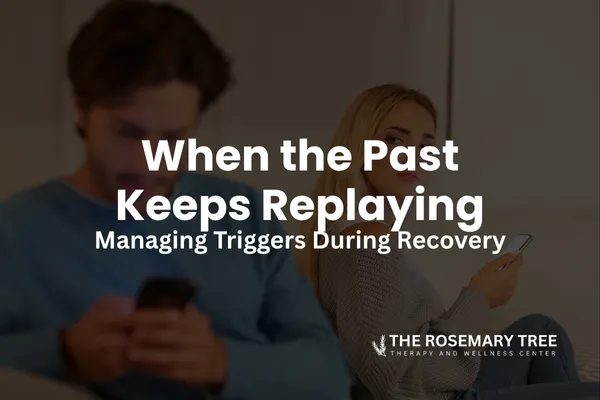
When the Past Keeps Replaying: Managing Triggers During Recovery
After betrayal, even when progress has been made, moments from the past can suddenly rush back, an image, a tone, or a phrase that reawakens old pain.
These experiences are called emotional triggers, and they can make both partners feel like they are right back in the early days after the affair. For the betrayed partner, the body may respond with panic, anger, or tears. For the partner who caused harm, the reaction can trigger shame, withdrawal, or fear.
Triggers are not signs of failure; they are signs of healing that still needs care. They happen because the nervous system has not yet learned that safety is permanent.
What Emotional Triggers Really Are
A trigger is not just a memory. It is the body’s survival response reactivated by something that feels familiar to the original wound.
It can be:
A look that seems distant or distracted
A delay in responding to a message
Seeing a reminder of the past relationship
Feeling disconnected during intimacy
Sensing a shift in tone or energy
The body reacts automatically, trying to protect itself from danger that no longer exists. The partner may intellectually know things are different now, but the body hasn’t fully caught up yet.
As we discussed in Betrayal Trauma vs. PTSD — Understanding the Overlap, this is part of how trauma lives in the nervous system. The goal is not to eliminate triggers completely but to learn how to move through them together.
How Triggers Affect Both Partners
For the betrayed partner, triggers feel like waves that appear without warning. They may feel flooded with questions or fear: Is this happening again?
For the partner who strayed, these moments can feel discouraging. They might think, I’ve apologized. Why does it keep coming up?
This mismatch can create frustration on both sides, but understanding what’s happening physiologically helps. The goal is not to avoid triggers but to navigate them as a team.
When couples approach triggers together instead of separately, healing deepens.
How to Manage Triggers Together
Pause Before Reacting
When a trigger arises, take a breath. Recognize what’s happening before responding. Slowing down prevents escalation and allows compassion to surface.Name What You Feel
The betrayed partner might say, “I’m feeling that same panic again.” The other partner can respond, “I hear you. I’m here. You’re safe with me.” Naming the experience out loud helps both people stay connected instead of reactive.Avoid Defensiveness
Defensiveness often restarts old conflict cycles. The goal is to validate, not justify. Respond with empathy, not explanation.Use Soothing Tools Together
Try deep breathing, grounding exercises, or physical reassurance, a hand on the shoulder, steady eye contact, or quiet presence. These small gestures teach the body that safety is still here.Debrief After the Moment Passes
When things calm down, talk about what helped or didn’t. These moments create a shared understanding for the next time a trigger appears.
When Triggers Feel Too Big to Handle
Some triggers feel overwhelming, like the body is reliving the pain all over again. When this happens, couples may need professional guidance to avoid retraumatizing each other.
That’s where structured therapy becomes invaluable. In a safe, guided environment, couples can process these emotional spikes, learn to recognize their origins, and replace reactivity with compassion.
How Accelerated Outcomes Therapy Helps
Our Accelerated Outcomes Therapy Intensives are designed to help couples move through triggers in real time with therapeutic support.
In these intensives, couples can:
Learn to identify emotional and physical signs of triggering
Practice grounding and regulation tools as a team
Explore the deeper meaning behind recurring emotional pain
Create a shared plan for safety when triggers arise in daily life
Instead of shutting down or spiraling apart, couples leave knowing how to stay connected through emotional storms.
This structured environment gives both partners the opportunity to practice what healing feels like, safe, guided, and supported.
Tying It Back to Attachment and Accountability
Triggers are not just reminders of the past; they are invitations for the couple to rebuild attachment safety in the present.
As explored in Healing the Attachment Wound — Moving From Fear to Safety, attachment repair happens when partners can stay emotionally connected even during distress. Accountability plays a key role here too. When the partner who caused harm responds with empathy and patience, they teach the other’s nervous system that safety is possible again.
Each moment handled with care becomes another brick in the foundation of trust.
Final Thoughts
Healing after betrayal doesn’t mean the past disappears. It means you learn how to carry it differently, together.
Triggers are reminders of what was lost, but they can also become opportunities to deepen safety, honesty, and compassion. Every time you face a trigger with care instead of fear, you strengthen the bond that betrayal once broke.
If you and your partner are still struggling with emotional triggers and want guided support, we would be honored to help. You can reach out to us here, and our team will connect with you to talk about what this process could look like. There is no pressure, only understanding and space to heal at your own pace.
